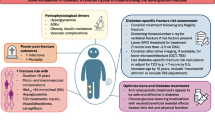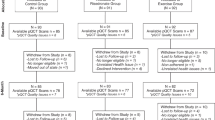Abstract
The two most important risk factors for long-term skeletal health are the peak bone mass and the subsequent rate of bone loss. The rate of bone loss after skeletal maturity is determined by both genetic factors and environmental factors. Furthermore, all factors that impair estrogen production will increase bone loss. The present risk of developing osteoporosis and fractures may be assessed by bone mass measurements in the total skeleton, or in local parts of the skeleton such as the spine, hip and forearm, by single-photon/X-ray absorptiometry (SPA or SXA), dual-photon/energy X-ray absorptiometry (DPA or DXA), or quantitative computed tomography (QCT). Furthermore, the rate of bone loss in postmenopausal women may be assessed by means of a number of biochemical markers. The fútúre risk of developing osteoporosis may thus be determined by combining the values for bone mineral content and bone loss.
Similar content being viewed by others
References
Johnston CC, Slemenda CW. Peak bone mass, bone loss and risk of fracture. Osteoporosis Int 1994;4 (Suppl 1):S43–5.
Melton LJ, Chao EYS, Lane J. Biomechanical aspects of fractures. In: Riggs BL, Melton LJ, editors. Osteoporosis: etiology, diagnosis, and management. New York: Raven Press, 1988:111–31.
Jensen GF, Christiansen C, Transbøl I. Fracture frequency and bone preservation in postmenopausal women treated with oestrogen. Obstet Gynecol 1982;60:493–6.
Nachtigall LE, Nachtigall RH, Nachtigall RD, Beckman EM. Estrogen replacement therapy. I. A 10-year prospective study in the relationship to osteoporosis. Obstet Gynecol 1979;53:277–81.
Lindsay R, Hart DM, Forrest C, Baird C. Prevention of spinal osteoporosis in oophorectomized women. Lancet 1980;2:1151–4.
Hui SL, Slemenda CW, Johnston CC Jr. Age and bone mass as predictors of fracture in a prospective study. J Clin Invest 1988;81:1804–9.
Ross PD, Wasnich RD, Vogel JM. Detection of prefracture spinal osteoporosis using bone mineral absorptiometry. J Bone Miner Res 1988;3:1–11.
Heaney RP, et al. En recherche de la difference (p<0.05). Bone Miner 1986;1:99–114.
Gotfredsen A, Pødenphant J, Nørgaard H, Nilas L, Nielsen V-AH, Christiansen C. Accuracy of lumbar spine bone mineral content by dual photon absorptiometry. J Nucl Med 1988;29:248–54.
Consensus Development Conference. Diagnosis, prophylaxis, and treatment of osteoporosis. Am J Med 1993;94:646–50.
Scientific Advisory Board of the National Osteoporosis Foundation. J Bone Miner Res 1989; 4 (Suppl 2).
Hansen MA, Riis BJ, Overgaard K, Hassager C, Christiansen C. Bone mass measured by photon absorptiometry: comparison of forearm, heel, and spine. Scand J Clin Lab Invest 1990;50:517–23.
Mazess R, Cameron JR. Direct readout of bone mineral content using radionuclide absorptiometry. Int J Appl Radiat Isot 1972;23:471–9.
Nilas L, Hassager C, Christiansen C. Long-term precision of dual photon absorptiometry in the lumbar spine in clinical settings. Bone Miner 1988;3:305–15.
Wahner HW, Dunn WL, Mazess RB, et al. Dual photon Gd-153 absorptiometry of bone. Radiology 1985;156:203–6.
Hansen MA, Hassager C, Overgaard K, Marslew U, Riis BJ, Christiansen C. Dual energy x-ray absorptiometry: a precise method of measuring bone mineral density in the lumbar spine. J Nucl Med 1990;31:1156–62.
Kim, et al. Abstract presented at RSNA'89, Chicago 26 November–1 December 1989.
Christiansen C, Riis BJ, Rødbro P. Prediction of rapid bone loss in postmenopausal women. Lancet 1987;1:1105–8.
Christiansen C, Riis BJ, Rødbro P. Screening procedure for women at risk of developing postmenopausal osteoporosis. Osteoporosis Int 1990;1:35–40.
Nilas L, Christiansen C. Bone mass and its relationship to age and the menopause. J Clin Endocrinol Metab 1987;65:697–702.
Civitelli R, Gonnelli S, Zacchei F, et al. Bone turnover in postmenopausal osteoporosis: effect of calcitonin treatment. J Clin Invest 1988;82:1268–74.
Hansen MA, Overgaard K, Riis B J, Christiansen C. Role of peak bone mass and bone loss in postmenopausal osteoporosis: 12 year study. BMJ 1991;303:961–4.
Riis BJ. Consensus Development Conference 1993. Diagnosis, prophylaxis and treatment of osteoporosis. Biochemical markers. II Clinical use. Am J Med (Submitted).
Hassager C, Jensen SB, Gotfredsen A, Christiansen C. The impact of measurement errors in diagnostic value of bone mass. Osteoporosis Int 1991:1:250–6.
Author information
Authors and Affiliations
Rights and permissions
About this article
Cite this article
Christiansen, C. Postmenopausal bone loss and the risk of osteoporosis. Osteoporosis Int 4 (Suppl 1), S47–S51 (1994). https://doi.org/10.1007/BF01623436
Issue Date:
DOI: https://doi.org/10.1007/BF01623436




